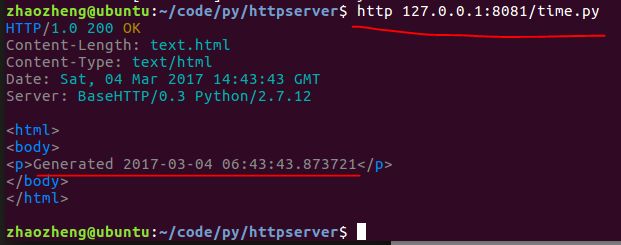1. 什么是CGI?
CGI即通用网关接口(Common Gateway Interface),是外部应用程序(CGI程序)与Web服务器之间的接口标准,是在CGI程序和Web服务器之间传递信息的规程。CGI规范允许Web服务器执行外部程序,并将它们的输出发送给Web浏览器,CGI将Web的一组简单的静态超媒体文档变成一个完整的新的交互式媒体。
下面是我个人对CGI的理解
就是最早的web服务器,只能处理静态页面的响应,比如 localhost/index.html 。但是有的时候,浏览器需要和服务器进行数据的交互,是一个动态的网页。
比如说,浏览器提交了账号和密码,提交给服务器,服务器收到数据之后,然后返回一个计算的结果。这就是动态的页面了。
比如,输入一个网页是 localhost/.index.php,localhost/index.jsp,localhost/index.py 。
比如说,写php的时候,服务器的目录下面可能会有这样的文件,文件名是 index.php
当浏览器请求 localhost/index.php 这个文件的时候,其实服务器并不会立刻把这个文件返回给服务器,它会先在自己这边执行一下,然后把执行的结果返回给服务器。
这就是我理解的CGI。
下面想写得是,在这个简单的web服务器上去支持cgi。
比如说,当浏览器输入 localhost/time.py 的时候,返回的不是一个静态的固定的网页,而是能够返回当前的时间。这个就需要服务器能够支持对动态网页的响应。也就是说,服务器收到浏览器的请求之后,先在服务器端执行一下进程,然后在把执行的结果返回。
运行结果 是这样
增加了对脚本文件的处理
class case_cgi_file(object):
'''脚本文件处理'''
#判斷一下當前的服務器上有沒有這個文件
def test(self, requesthandler):
return os.path.isfile(requesthandler.full_path) and \
requesthandler.full_path.endswith('.py')
#如果有的話,就去執行
def act(self, requesthandler):
##运行脚本文件
self.run_cgi(requesthandler)
#去執行這個python腳本,執行之後將結果返回
def run_cgi(self,requesthandler):
data = subprocess.check_output(["python", requesthandler.full_path])
#將執行的結果返回個瀏覽器
requesthandler.send_content(data)
这是全部的代码:
#coding:utf-8
import sys,os,BaseHTTPServer
from datetime import datetime
import subprocess
class case_cgi_file(object):
'''脚本文件处理'''
#判斷一下當前的服務器上有沒有這個文件
def test(self, requesthandler):
return os.path.isfile(requesthandler.full_path) and \
requesthandler.full_path.endswith('.py')
#如果有的話,就去執行
def act(self, requesthandler):
##运行脚本文件
self.run_cgi(requesthandler)
#去執行這個python腳本,執行之後將結果返回
def run_cgi(self,requesthandler):
data = subprocess.check_output(["python", requesthandler.full_path])
#將執行的結果返回個瀏覽器
requesthandler.send_content(data)
#RequestHandler 繼承 BaseHTTPRequestHandler ,所以他自身就有一個path的數據成員
class RequestHandler(BaseHTTPServer.BaseHTTPRequestHandler):
Error_Page="""\
Error accessing {path}
{msg}
"""
Cases=[case_cgi_file()]
#這裏的self其實是 RequestHandler對象
def do_GET(self):
try:
self.full_path = os.getcwd() + self.path
for case in self.Cases:
if case.test(self):
case.act(self)
break
except Exception as msg:
self.handle_error(msg)
def handle_error(self,msg):
content=self.Error_Page.format(path=self.path,msg=msg)
self.send_content(content,404)
def send_content(self,page,status=200):
#print 'send_content function '
self.send_response(status)
self.send_header('Content-Type','text/html')
self.send_header('Content-Length','text.html')
self.end_headers()
self.wfile.write(page)
if __name__ == '__main__':
serverAddress = ('', 8081)
server = BaseHTTPServer.HTTPServer(serverAddress, RequestHandler)
server.serve_forever()
gitbub 链接:https://github.com/zhaozhengcoder/Python
关于python 创建一个子线程
去执行其他的可执行文件的用法。这个很像linux下的 exec()函数。如果感兴趣的话,可以去深入了解subprocess库。
import subprocess
path='./echo.py'
res=subprocess.check_output(["python",path])
print res


